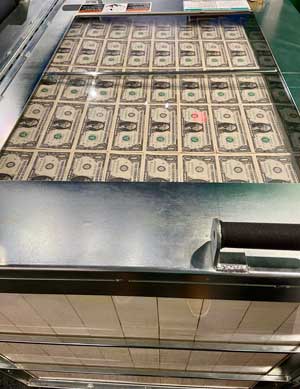Nearly One Billion Notes and a 90,000-Pound Door: Peek inside Our Vault
Where banks go when they need a bank: The Federal Reserve, often called “the bankers’ bank,” provides financial services to institutions like banks, savings and loans, and credit unions—similar to the services a community or commercial bank provides to you, the customer.
The St. Louis Fed, for example, offers cash management services to many banks within and outside the Eighth Federal Reserve District, which includes all of Arkansas, eastern Missouri, southern Indiana, southern Illinois, western Kentucky, western Tennessee and northern Mississippi. An important role of the Fed is to ensure that financial institutions have enough currency (paper cash) and coin on hand to meet customers’ needs. After all, have you ever wondered where your bank goes to get money?
In addition to distributing currency and coin to District banks, the St. Louis Fed receives currency in two ways: deliveries from the Bureau of Engraving and Printing, which is the U.S. Treasury bureau responsible for printing new money, and cash deposits from financial institutions. Across the nation, more than 5,000 depository institutions have accounts at the 12 Federal Reserve banks. Institutions maintain balances and make and receive payments from those accounts. You may have heard these deposits referred to as “reserves.”
So, if the St. Louis Fed is taking in and sending out cash on a daily basis, where does it store it all?
Enter the Vault
Coming in at 90,000 pounds … the St. Louis Fed’s cash vault door! You read that right—the door alone tips the scales at 45 tons. You might be asking, “How can a single person open or close a door that weighs more than six elephants?” Thanks to some clever engineering, the vault door can be opened and closed by one person and slides easily along a track in the floor.

Get a glimpse inside Currency Operations at the Federal Reserve Bank of St. Louis.
Here at the St. Louis Fed, the vault acts mainly as a secure storage facility. Rows of cash containers are filled with deposits from commercial banks and are securely stored in the vault, waiting be counted and processed.
When a bank, credit union or savings and loan institution needs more currency, a Reserve bank prepares and releases clean, undamaged—or fit—currency to an armored carrier. A Reserve bank also accepts cash deposits from these institutions and verifies them on high-speed processing equipment.
Vaults are an integral part of safeguarding banks’ deposits, and as such need to stand the test of time. In the two images below, you can see that the same fortified vault door from the 1920s (shown in 1940 in the left photo) is used in today’s secure cash environment.

Left, an officer guards the St. Louis Fed vault after the door was prepared for closing in 1940. Right, the vault door today.
What Does It Take to Process and Count All That Cash?

You’ve seen a grocery cart, but what about a cash cart? Check out one in person at our Economy Museum.
Cash is in motion all the time. From your local grocery store to a wallet halfway around the world. All the U.S. currency in circulation was put there by a regional Federal Reserve bank. Across all 12 Reserve banks, approximately 33 billion notes are received and processed annually by the Fed. Processing cash from a bank includes:
- Receiving the deposit from an armored carrier
- Counting the cash to ensure the correct amount is deposited
- Inspecting and sorting the currency via high-speed processing technology
- Eliminating currency that is damaged or suspected to be counterfeit
The St. Louis Fed headquarters, along with our branch office in Memphis, Tenn., processes over 900 million notes (paper currency) each year. Among those processed and inspected in 2022, a whopping 136 million were removed from circulation, shredded and composted. Why? That cash was worn, mutilated or otherwise deemed unfit for circulation and so needed to be replaced.
In addition, 1,924 notes were removed from circulation because they were suspected to be counterfeit currency. The counterfeit notes are sent to the U.S. Secret Service for further investigation and inspection.
Bonus Blog Posts
Think You’ve Got What It Takes to Join Our Currency Team?
Interested in seeing inside the vault? Want to join the fast-paced, advanced-technology team in our Currency Operations group? Check out this video on Currency Operations to learn what it’s like to be counted as a part of our team.
This blog explains everyday economics and the Fed, while also spotlighting St. Louis Fed people and programs. Views expressed are not necessarily those of the St. Louis Fed or Federal Reserve System.
Email Us


